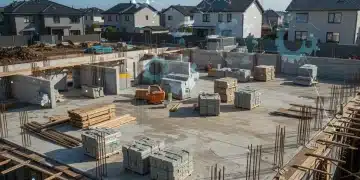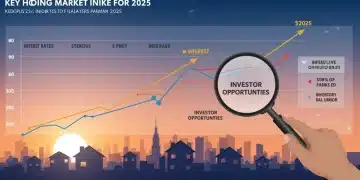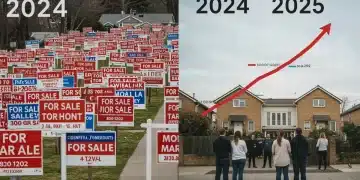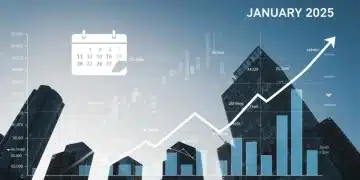The 2025 Real Estate Market: Demand & Supply Trends Insight

The 2025 Real Estate Market is poised for significant shifts, driven by evolving demographic patterns, interest rate adjustments, and construction bottlenecks, demanding close scrutiny from investors and homeowners alike.
As we approach 2025, the conversation around the 2025 Real Estate Market: A Deep Dive into Demand and Supply Trends (INSIDER KNOWLEDGE) intensifies. What factors will truly shape property values and availability? This report provides an immediate, factual overview of the forces at play, offering critical insights for anyone navigating the complex world of real estate.
Economic Indicators Shaping 2025 Real Estate
The economic landscape remains a primary driver for the 2025 real estate market. Current projections suggest a period of continued economic adjustment, with inflation and interest rates dictating borrowing costs and consumer confidence. Analysts are closely watching central bank policies, as any shifts will directly impact mortgage rates and, consequently, buyer affordability.
Recent data, as of late 2024, indicates a stabilization in some economic sectors, yet others show persistent volatility. This mixed signal creates a cautious but not entirely pessimistic outlook for real estate, where localized economic strength will play an increasingly significant role.
Interest Rate Trajectories
The Federal Reserve’s stance on interest rates is paramount. While recent hikes have cooled some overheated markets, the consensus suggests a potential for minor rate adjustments rather than significant cuts or increases in 2025. This creates a predictable, albeit still elevated, borrowing environment.
- Mortgage Rates: Expected to remain above pre-pandemic levels, influencing buyer budgets.
- Inflation Control: Continued efforts by central banks to manage inflation will dictate future rate movements.
- Economic Growth: Stronger economic performance could lead to sustained higher rates.
Employment and Wage Growth
Robust employment figures and steady wage growth are critical for sustaining housing demand. As reported by the Bureau of Labor Statistics, the job market has shown resilience, contributing to consumers’ ability to afford housing. However, disparities in wage growth across different industries could create regional variations in housing market strength.
Where high-paying jobs are concentrated, demand for housing will likely remain strong. Conversely, areas with stagnant wages may see a softening in demand, leading to more balanced markets for buyers. These dynamics are crucial for understanding localized trends.
Evolving Demand Patterns: Who is Buying and Where?
Understanding demand is central to forecasting the 2025 real estate market. Demographic shifts, including the aging of millennials and the emergence of Gen Z as first-time homebuyers, are fundamentally altering market requirements. Urban flight trends, though somewhat moderated, continue to influence suburban and rural property values, creating new hotspots.
The desire for more space, fueled by remote work flexibility, persists. This is particularly evident in areas offering a blend of affordability, amenities, and connectivity, moving beyond traditional metropolitan hubs. These shifts are not uniform, requiring granular analysis.
Millennials and Gen Z Entry
Millennials, now firmly in their prime homebuying years, continue to drive a significant portion of demand. Their preferences for move-in ready homes and accessible communities are shaping new construction and renovation trends. Gen Z, while younger, is beginning to enter the market, often prioritizing sustainability and technological integration in their housing choices.
- First-time Homebuyers: Both generations face affordability challenges, impacting market entry points.
- Location Preferences: A mix of urban accessibility and suburban space is increasingly sought after.
- Digital Integration: High demand for smart home features and reliable internet infrastructure.
Remote Work Impact
The long-term effects of remote work continue to ripple through the real estate sector. While not everyone has fully embraced remote work, a significant portion of the workforce now has hybrid or fully remote options. This flexibility allows buyers to consider properties further from traditional business districts, increasing demand in secondary markets.
This dispersion of the workforce is leading to a re-evaluation of property values in previously overlooked towns and cities, creating opportunities for growth outside of the major urban centers. Developers are responding by planning mixed-use communities in these emerging areas.
Supply-Side Dynamics: Construction and Inventory Challenges
The supply side of the 2025 real estate market faces its own set of challenges, predominantly stemming from persistent construction bottlenecks and limited existing inventory. While some regions are seeing an uptick in new builds, it’s often not enough to meet the sustained demand, particularly for affordable housing segments.
Material costs, labor shortages, and regulatory hurdles continue to impede the pace of new construction. This imbalance between available homes and eager buyers continues to exert upward pressure on prices in many markets, though some relief is anticipated as economic conditions stabilize.
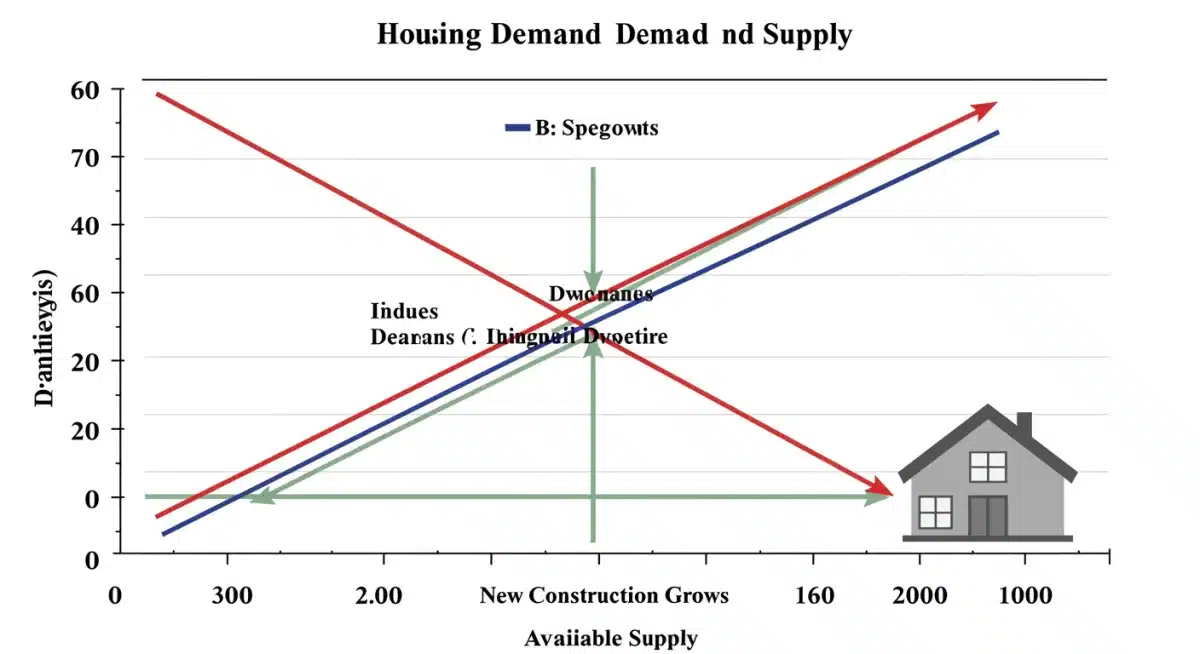
Construction Bottlenecks
Despite efforts to increase housing starts, the construction industry struggles with several constraints. The cost of raw materials, such as lumber and steel, remains elevated, directly impacting development budgets. Furthermore, a shortage of skilled labor continues to delay project timelines and increase overall building expenses.
These factors collectively contribute to a slower-than-desired pace of new home delivery, exacerbating the existing housing deficit. Policy incentives and technological advancements in construction are being explored to mitigate these issues, but their full impact will take time to materialize.
Existing Home Inventory
The availability of existing homes for sale remains historically low in many areas. Homeowners, often locked into lower mortgage rates, are hesitant to sell, fearing higher borrowing costs on a new property. This ‘golden handcuffs’ effect reduces the churn in the market, limiting options for prospective buyers.
This constrained inventory means that well-maintained properties in desirable locations continue to command premium prices and often sell quickly. A significant increase in interest rates or a major economic downturn would be needed to unlock a substantial wave of existing homes onto the market, neither of which is currently projected as a primary scenario for 2025.
Regional Market Spotlights: Hotbeds and Cooling Zones
The national real estate picture often masks significant regional variations, and 2025 will be no different. Certain areas are projected to experience continued growth, driven by strong job markets and population influx, while others may see a more moderate or even cooling trend. Understanding these localized dynamics is crucial for both buyers and sellers.
Sunshine states and areas with burgeoning tech sectors are typically identified as hotbeds, whereas regions heavily reliant on industries facing structural changes might experience slower appreciation. This divergence underscores the importance of hyper-local market analysis.
Emerging Growth Markets
Markets in the Southeast and Southwest are frequently cited for their robust growth potential. Cities in Florida, Texas, and Arizona, for instance, continue to attract new residents and businesses, fueling housing demand. These areas often boast lower taxes, favorable climates, and expanding job opportunities, making them attractive relocation destinations.
- Florida: Continued population growth, particularly from retirees and remote workers.
- Texas: Strong job creation in tech and energy sectors driving demand.
- Arizona: Affordable living costs and expanding infrastructure attracting new residents.
Markets Facing Headwinds
Conversely, some markets, particularly those with high existing property values and limited new development capacity, may face headwinds. High cost of living, combined with a potential slowdown in job growth, could lead to a flattening or even slight decline in property values. Northeastern and Californian markets, while resilient, often face these pressures.
Additionally, areas with an oversupply of certain property types, or those experiencing out-migration, might see a more buyer-friendly environment. These dynamics highlight the need for careful due diligence before making real estate decisions.
Technological Innovations and Sustainability
Technology continues to revolutionize the real estate sector, influencing everything from property search to construction methods and smart home integration. In 2025, we anticipate further advancements that will streamline transactions, enhance property management, and promote sustainable living. These innovations are not just conveniences; they are becoming essential components of modern housing.
Sustainability is moving from a niche concern to a mainstream expectation, with buyers increasingly prioritizing energy-efficient homes and eco-friendly features. This shift is driving demand for green building practices and retrofits, impacting property values and appeal.
Smart Home Integration
The proliferation of smart home technology is set to continue. Buyers expect integrated systems for security, climate control, lighting, and entertainment. Properties equipped with advanced smart home features are likely to command higher interest and potentially higher prices, reflecting their added value and convenience.
Developers are incorporating these technologies from the ground up, recognizing that connectivity and automation are key selling points for modern consumers. The ease of managing a home through a single interface is a significant draw, especially for tech-savvy generations.
Sustainable Building Practices
Sustainability is no longer just a buzzword; it’s a critical component of construction and buyer preference. Energy-efficient appliances, solar panels, superior insulation, and water-saving fixtures are becoming standard. Properties with lower carbon footprints and reduced utility bills are highly attractive in the current market.
- Energy Efficiency: High demand for homes with low utility costs and sustainable energy sources.
- Green Certifications: Properties with LEED or similar certifications gain a competitive edge.
- Eco-friendly Materials: Increased use of recycled and sustainably sourced building materials.
Government Policies and Regulatory Landscape
Government policies and the regulatory landscape will play a pivotal role in shaping the 2025 real estate market. Decisions regarding zoning, affordable housing initiatives, and taxation can significantly impact both supply and demand. These interventions aim to address market imbalances, promote equitable access to housing, and stimulate economic activity.
Changes in property tax laws, capital gains taxes, or first-time homebuyer programs can either incentivize or deter market participation. Staying informed about these policy shifts is essential for all stakeholders in the real estate ecosystem.
Affordable Housing Initiatives
Many governments are intensifying efforts to address the affordable housing crisis. This includes offering incentives for developers to build more entry-level homes, providing down payment assistance programs, and exploring rent control measures. These initiatives aim to make homeownership more accessible and alleviate rental market pressures.
The effectiveness of these programs varies by region, but their presence indicates a concerted effort to mitigate the widening gap between housing costs and average incomes. Developers and investors must be aware of these evolving policies.
Zoning and Land Use Reforms
Zoning laws and land-use regulations are critical determinants of housing supply. Many municipalities are reviewing and reforming their zoning codes to allow for higher density development, mixed-use projects, and reduced minimum lot sizes. These reforms are designed to increase housing availability and reduce development costs.
However, these changes often face local opposition, making their implementation a slow and complex process. The success of these reforms will be a key factor in how quickly new housing can come online to meet demand in the coming years.
| Key Trend | Brief Description |
|---|---|
| Interest Rate Stability | Anticipated stability in interest rates, influencing mortgage affordability. |
| Demographic Shifts | Millennials and Gen Z driving demand with new preferences and challenges. |
| Supply Constraints | Ongoing challenges in construction and limited existing home inventory. |
| Regional Divergence | Significant differences expected in market performance across various regions. |
Frequently Asked Questions About the 2025 Real Estate Market
The primary factors include interest rate trajectories from central banks, overall inflation levels, and the strength of employment and wage growth across different sectors. These elements collectively determine borrowing costs and consumer purchasing power.
Millennials will continue as a major force in homebuying, while Gen Z will increase their market entry, prioritizing technology and sustainability. These generations will shape demand for specific property types and locations, moving away from traditional urban centers.
Supply challenges stem from persistent construction bottlenecks, including high material costs and labor shortages. Additionally, limited existing home inventory, influenced by homeowners locked into lower mortgage rates, continues to constrain market options.
Regions in the Southeast and Southwest, such as parts of Florida, Texas, and Arizona, are projected to experience notable growth. These areas benefit from strong job markets, population migration, and favorable economic conditions, attracting both residents and businesses.
Properties with advanced smart home integration and strong sustainability features, like energy efficiency and green certifications, will likely command higher values. Buyers increasingly prioritize these elements, driving innovation in construction and renovation practices across the market.
Looking Ahead – Navigating the Next Chapter of Real Estate
The 2025 real estate market is poised to enter a transformative phase, defined by shifting economic cycles, generational buyer dynamics, and the steady integration of digital infrastructure into every layer of the property ecosystem. As affordability pressures persist and supply constraints challenge both urban and suburban areas, the ability to anticipate and adapt will determine long-term success for developers, investors, and policymakers alike.
Beyond short-term fluctuations, deeper structural trends—such as remote work normalization, demographic transitions, and sustainability-driven design standards—are reshaping not only where Americans live but how they evaluate property value and community connection. These evolving forces are prompting industry players to diversify portfolios, explore mixed-use developments, and prioritize resilience in both construction and financing models.
For those seeking to understand the trajectory of the housing sector, insights from the U.S. News Housing Market Predictions provide a comprehensive outlook on how macroeconomic factors, mortgage rate trends, and government policies will influence the real estate landscape over the next five years. These projections highlight a likely moderation in price growth, gradual inventory recovery, and renewed opportunities in underdeveloped regional markets.
Looking ahead, the resilience of the housing market will depend on coordination between financial institutions, urban planners, and technology innovators who can align investment strategies with evolving consumer realities. Stakeholders who embrace data-driven forecasting, sustainable construction, and adaptive financing tools will not only navigate uncertainty but help define the next era of accessible, stable, and equitable housing in the United States.

